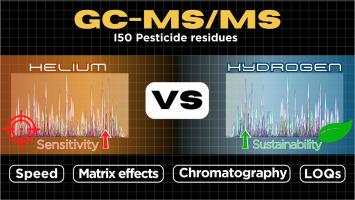Hydrogen vs. Helium as carrier gases in GC-MS/MS for pesticide residue analysis: a comparative evaluation
IF 6.2
引用次数: 0
Abstract
This study presents a comprehensive comparison between helium and hydrogen as carrier gases in gas chromatography coupled with tandem mass spectrometry (GC-MS/MS) for multiresidue pesticide analysis. Using a shared instrumental platform, method parameters were carefully adapted for each carrier gas to maintain equivalent chromatographic efficiency, including adjustments to column dimensions, flow rates, and oven temperature programs. Method performance was evaluated in terms of chromatographic resolution, sensitivity, matrix effects, and regulatory reliability across tomato, pepper, and zucchini matrices. Hydrogen demonstrated faster analysis times and improved resolution in several cases, particularly in separating matrix interferences. However, helium consistently offered higher sensitivity, especially at lower concentrations. At 2 µg/kg, helium enabled the identification of over 90 % of compounds in most matrices, while hydrogen remained below 55 %. Matrix effect evaluations showed slightly better results with helium, though both gases provided acceptable performance, with most compounds falling within the negligible effect range. A proficiency test sample further validated the method, confirming that both gases produced results within acceptable z-score limits. Overall, hydrogen proved to be a viable and sustainable alternative for routine applications, though helium remains preferable when ultra-trace sensitivity or method robustness under stricter regulatory conditions is required.

气相色谱-质谱联用分析中载气氢与载气氦的比较评价
本文研究了气相色谱-串联质谱(GC-MS/MS)联用多残留农药分析中氦气和氢气作为载气的比较。使用共享的仪器平台,对每种载气的方法参数进行仔细调整,以保持等效的色谱效率,包括调整柱尺寸,流速和烤箱温度程序。从色谱分辨率、灵敏度、基质效应和番茄、辣椒和西葫芦基质的调控可靠性等方面对方法进行了评价。氢气在几种情况下显示出更快的分析时间和更高的分辨率,特别是在分离基质干扰时。然而,氦气始终提供更高的灵敏度,特别是在较低浓度下。在2µg/kg时,氦能够识别大多数基质中90%以上的化合物,而氢仍然低于55%。矩阵效应评价表明,氦的效果稍好一些,尽管两种气体都提供了可以接受的性能,大多数化合物的影响范围可以忽略不计。熟练测试样品进一步验证了该方法,确认两种气体产生的结果都在可接受的z分数范围内。总的来说,氢气被证明是常规应用的可行和可持续的替代方案,尽管在更严格的监管条件下需要超痕量灵敏度或方法稳健性时,氦气仍然是首选。
本文章由计算机程序翻译,如有差异,请以英文原文为准。
求助全文
约1分钟内获得全文
求助全文

 求助内容:
求助内容: 应助结果提醒方式:
应助结果提醒方式:


